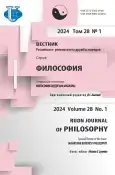Buddhist Perspectives on Death
- Authors: Gokhale P.P.1
-
Affiliations:
- Central University of Tibetan Studies
- Issue: Vol 28, No 1 (2024): MAHAYANA BUDDHIST PHILOSOPHY
- Pages: 37-46
- Section: MAHAYANA BUDDHIST PHILOSOPHY
- URL: https://journal-vniispk.ru/2313-2302/article/view/325443
- DOI: https://doi.org/10.22363/2313-2302-2024-28-1-37-46
- EDN: https://elibrary.ru/DLCJEE
- ID: 325443
Cite item
Full Text
Abstract
The study deals with some of the central issues concerning the notion of death as discussed in Theravāda (Pāli Buddhism) as well as Mahāyāna Buddhism. What is the sense that death is regarded as an instance of duḥkha (Sanskrit) or dukkha (Pāli)? The research claims that here, firstly, the word duḥkha/dukkha is used as an adjective (which means ‘unsatisfactory’) rather than a noun (which means 'pain' or 'suffering'). Secondly, by death, the Buddha did not mean the act of dying but the experience of someone's death or the idea of death. The Buddha also talked about deathlessness as the goal. Here, deathlessness does not amount to accepting something eternal but developing a proper perspective towards death by meditations such as that on impurity ( аśubhabhāvanā ) and contemplation on death ( maraṇānussati ). If the cessation of the cycle of rebirths and re-deaths ( punarmṛtyu ) is the ultimate goal that the arhat (Sanskrit), or arahant (Pāli), achieves, then the same should apply to Tathāgata. In that case, the problem suggests itself: how could the question of Tathāgata’s existence after death be accounted for as an unanswerable ( avyākṛta )? The study opines that the reason behind this is the profound, immeasurable, unfathomable nature attributed to Tathāgata. The research also discusses the basic difference between the attitudes on death in Śrāvakayāna and Mahāyāna. Lastly, it deals with the question of whether termination of one’s own life is permissible in Buddhism under certain conditions.
Keywords
About the authors
Pradeep P. Gokhale
Central University of Tibetan Studies
Author for correspondence.
Email: pradeepgokhale53@gmail.com
Professor, Research Department 1 Mavaiya St., 221007, Sarnath, India
References
- Walshe M. The Long Discourses of the Buddha: A Translation of the Dīghanikāya. Nikaya D, transl. Boston: Wisdom Publications; 1995.
- Buddhaghosa.Visuddhimagga. In 2 vols. London: Pali Text Society; 1920-1921.
- Mullin GH. Death and Dying: The Tibetan Tradition. New York: Arkana Paperbacks, Toutledge and Kegan Paul Inc; 1986.
- Davids TWR, Oldenberg H, transl. Vinayapiṭaka. In: Sacred Books of the East. Pt. I. Delhi: Motilal Banarsidass; 1974.
- Bhikkhu Ñ, Bhikkhu B, transl. The Middle Length Discourses of the Buddha. Boston: Wisdom Publications; 1995.
- Davids TWR, transl. The Questions of King Milinda (Milindapañhapāli). Part I. Delhi: JP Publishing House; 2013.
- Vaidya PL, editor. Madhyamakaśāstra of Nāgārjuna with the Commentary Prasannapadā by Candrakīrti. Darbhanga: The Mithila Institute; 1960.
- Williams P. Mahāyāna Buddhism: The Doctrinal Foundations. New York: Routledge; 1989.
- Lalmani J. Studies in the Buddhistic Culture of India. Delhi: Motilal Banarsidass; 1967.
- Gowans KW. Buddhist Moral Philosophy: An Introduction. New York: Routledge; 2015.
Supplementary files









